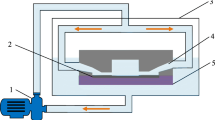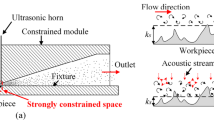Abstract
The fluid medium used for soft abrasive flow (SAF) is of low viscosity and high flow velocity. The conventional SAF processing method is widely used due its ability to avoid damage and its adaptability of the workpiece surface. However, the current SAF method also suffers from limitations such as long polishing times and low processing efficiency. To address these issues, this paper proposes a method based on the cavitation effect to assist the soft abrasive flow polishing, termed CSAF. First, the working mechanism of CSAF is introduced through a schematic diagram. In addition, a CSAF fluid mechanic model is configured on the basis of the mixture multiphase model and cavitation model. Then, the distribution of key flow parameters, such as the velocity, dynamic pressure, and turbulent kinetic energy, is obtained and compared through computational fluid dynamic software. Numerical analysis results show that the flow field assisted by the cavitation effects shows better processing performance than SAF. Finally, particle imaging velocity (PIV) observation and experimental processing platforms are established, and extensive experiments are conducted. The processing comparison experiments showed that the abrasive flow assisted by the cavitation effect can lower the workpiece surface roughness to 3.46 nm with a satisfactory surface quality over a shorter time than the SAF method. The numerical analysis results are aligned with the PIV observation and the polishing experiment results. The SAF polishing method based on the cavitation effect significantly increases the polishing efficiency.
Similar content being viewed by others
References
Beaucamp A, Namba Y (2013) Super-smooth finishing of diamond turned hard X-ray molding dies by combined fluid jet and bonnet polishing. CIRP Ann Manuf Technol 62(1):315–318
Halverson S, Roy A, Mahadevan S (2015) An efficient, compact, and versatile fiber double scrambler for high precision radial velocity instruments. Astrophys J 806(1)
Fan C, Hong G S, Zhao J, Zhang L, Zhao J, Sun LN (2018) The integral sliding mode control of a pneumatic force servo for the polishing process. Precis Eng (Article in Press). https://doi.org/10.1016/j.precisioneng.2018.09.001
Yang LG, Chen L, Bai R, Yang F, Wang M, Chen HZ (2007) Modelling of organic nanograting heterojunctions for photoelectric conversion. Sol Energy Mater Sol Cells 91(12):1110–1119
Liu Y, Tan J, Ma J (2012) Fabrication and shielding effectiveness evaluation of curved mesh optical windows using ray-optic tracing and equivalent film methods. Opt Commun 285(20):4015–4018
Tan DP, Zhang LB, Ai QL (2016) An embedded self-adapting network service framework for networked manufacturing system. J Intell Manuf (Article in Press). https://doi.org/10.1007/s10845-016-1265-3
Tan DP, Li L, Zhu YL, Zheng S, Ruan HJ, Jiang XY (2018) An embedded cloud database service method for distributed industry monitoring. IEEE Trans Ind Inform 14(7):2881–2893
Zhou H, Ding WF, Liu CJ.(2018) Material removal mechanism of PTMCs in high-speed grinding when considering consecutive action of two abrasive grains. Int J Adv Manuf Technol (Article in Press). https://doi.org/10.1007/s00170-018-2685-3
Qi H, Wen DH, Yuan QL, Zhang L, Chen ZZ (2017) Numerical investigation on particle impact erosion in ultrasonic-assisted abrasive slurry jet micro-machining of glasses. Powder Technol 314:627–634
Chen FJ, Miao XL, Tang Y, Yin SH (2016) A review on recent advances in machining methods based on abrasive jet polishing (AJP). Int J Adv Manuf Technol 90(1–4):785–799
Kar KK, Ravikumar NL, Tailor PB, Ramkumar J, Det S (2009) Performance evaluation and rheological characterization of newly developed butyl rubber based media for abrasive flow machining process. J Mater Process Technol 209(4):2212–2221
Guan F, Hu H, Li SY, Liu ZY, Peng XQ, Shi F (2018) A novel Lap-MRF method for large aperture mirrors. Int J Adv Manuf Technol 95(9–12):1–13
Kanaoka M, Takino H, Nomura K, Mori Y, Mimura H, Yamauchi K (2007) Removal properties of low-thermal-expansion materials with rotating-sphere elastic emission machining. Sci Technol Adv Mater 8(3):170–172
Fähnle OW, Brug H, Frankena HJ (1998) Fluid jet polishing of optical surfaces. Appl Opt 37(28):6771
Shiou FJ, Asmare A (2015) Parameters optimization on surface roughness improvement of Zerodur optical glass using an innovative rotary abrasive fluid multi-jet polishing process. Precis Eng 42:93–100
Li C, Ji SM, Tan DP (2012) Softness abrasive flow method oriented to tiny scale mold structural surface. Int J Adv Manuf Technol 61(9–12):975–987
Zhang L, Wang JS, Tan DP, Yuan ZM (2017) Gas compensation-based abrasive flow processing method for complex titanium alloy surfaces. Int J Adv Manuf Technol 92(9–12):3385–3397
Scheid B, Dorbolo S, Arriaga LR, Rio E (2012) Antibubble dynamics: the drainage of an air film with viscous interfaces. Phys Rev Lett 109(26):264502
Dorbolo S, Reyssat E, Vandewalle N, Quéré D (2007) Aging of an antibubble. Epl 69(6):966–970
Hutli E, Nedeljkovic MS, Bonyár A (2016) The ability of using the cavitation phenomenon as a tool to modify the surface characteristics in micro- and in nano-level. Tribol Int 101:88–97
Chen F, Wang H, Tang Y, Yin S, Huang S, Zhang G (2018) Novel cavitation fluid jet polishing process based on negative pressure effects. Ultrason Sonochem 42:339–346
Bing H (2012) Numerical simulation and verification of cavitation behavior in water-jet cavitation peening processing. J Mech Eng 48(15):193–198
Beaucamp A, Katsuura T, Kawara Z (2017) A novel ultrasonic cavitation assisted fluid jet polishing system. CIRP Ann Manuf Technol 66(1):301–304
Tan KL, Yeo SH (2017) Surface modification of additive manufactured components by ultrasonic cavitation abrasive finishing. Wear 378–379:90–95
Qi H, Cheng ZC, Cai DH, Yin LZ, Wang ZW, Wen DH (2018) Experimental study on the improvement of surface integrity of tungsten steel using acoustic levitation polishing. J Mater Process Technol 259:361–367
Sankar MR, Jain VK, Ramkumar J (2010) Rotational abrasive flow finishing (R-AFF) process and its effects on finished surface topography. Int J Mach Tools Manuf 50(7):637–650
Lv Z, Hou R, Tian Y, Huan C, Zhu H (2018) Numerical study on flow characteristics and impact erosion in ultrasonic assisted waterjet machining. Int J Adv Manuf Technol 98(1–4):373–383
Ge JQ, Ji SM, Tan DP (2017) A gas-liquid-solid three-phase abrasive flow processing method based on bubble collapsing. Int J Adv Manuf Technol 95(1–4):1069–1085
Bitter JGA (1963) A study of erosion phenomena part I. Wear 6(1):5–21
Nguyen T, Liu D, Thongkaew K, Li H, Qi H, Wang J (2018) The wear mechanisms of reaction bonded silicon carbide under abrasive polishing and slurry jet impact conditions. Wear 410-411:156–164
Gu YL, Li HN, Du BC, Ding WF (2018) Towards the understanding of creep-feed grinding of DD6 nickel-based single-crystal superalloy. Int J Adv Manuf Technol (Article in Press). https://doi.org/10.1007/s00170-018-2686-2
Qian N, Ding WF, Zhu YJ (2018) Comparative investigation on grindability of K4125 and Inconel 718 nickel-based superalloys. Int J Adv Manuf Technol 97:1649–1661
Jia X, Ling R (2007) Two-body free-abrasive wear of polyethylene, nylon1010, expoxy and polyurethane coatings. Tribol Int 40(8):1276–1283
Tan DP, Li L, Zhu YL, Zheng S, Yin ZC, Li DF (2018) Critical penetration condition and Ekman suction-extraction mechanism of sink vortex. J Zhejiang Univ-SCI A (Article in Press). https://doi.org/10.1631/jzus.A1800260
Coutier-Delgosha O, Fortes-Patella R, Reboud JL (2008) Evaluation of the turbulence model influence on the numerical simulations of unsteady cavitation. J Fluid Eng 125(1):38–45
Cheng W, Murai Y, Masa-Aki I, Yamamoto F (2003) An algorithm for estimating liquid flow field from PTV measurement data of bubble motion. Trans Visual Soc Jap 23(11):107–114
Mortensen HH, Arlov D, Innings F, Håkansson A (2018) A validation of commonly used CFD methods applied to rotor stator mixers using PIV measurements of fluid velocity and turbulence. Chem Eng Sci 177:340–353
Acknowledgments
This work is supported by the Chinese National Natural Science Foundation [grant numbers 51605438, 51575494] and the Zhejiang Provincial Xinmiao Talent Project [grant number 2017R403079].
Author information
Authors and Affiliations
Corresponding author
Rights and permissions
About this article
Cite this article
Ji, S., Cao, H., Zhao, J. et al. Soft abrasive flow polishing based on the cavitation effect. Int J Adv Manuf Technol 101, 1865–1878 (2019). https://doi.org/10.1007/s00170-018-2983-9
Received:
Accepted:
Published:
Issue Date:
DOI: https://doi.org/10.1007/s00170-018-2983-9




